DOREEN'S IMPRESSIONS OF
OUR VISIT TO THE
GORONGOSA NATIONAL PARK
GORONGOSA, MOCAMBIQUE
16-20 OCTOBER 2013
GO TO DOREEN AND EITAN'S HOME PAGE
For more on our SA trip, click
here.
The
three hour
drive from Beira to Gorongosa was a sobering experience as we passed
from poor
city to even poorer neighboring areas and then through outlying areas
that to
us, were in abject poverty. The severely rutted roads were busy, mainly
with
trucks, but also people walking and men riding bicycles. We saw mud
huts, some
really ramshackled and dilapidated, but we also saw some that were well
kept in
orderly gardens. By the road side there were women selling tomatoes,
some
cabbages, clothes and farther out, bundles of firewood. Everywhere we
saw
yellow jerry cans, their water containers. Everywhere
there were mango trees and many
banana plants, and in one place where trucks had to slow down for
customs
inspection, young boys were selling small packets of delicious cashew
nuts. And
yet, we had to face it that these villagers at least had fertile land
and
abundant rain; there are many places in Africa where the land is
parched and
the people starving.
We
arrived at
Gorongosa and were taken to our spacious rondavel with internet! A nice surprise. We
made our way to lunch and ordered a
starter. 35 minutes later, as we watched the large table next to us
being
served, I remarked to Anthony that they obviously don't know about
multitasking. He replied that they most probably don't even know single
tasking.
We burst out laughing when the wrong
starters were eventually placed in front of us!
But the food was good and we weren't in a hurry to go anywhere.
Gorongosa
is
not a Park for first or second time safari lovers. Gorongosa used to be
one of
the areas most densely populated by animals until the 1960s when civil
war
broke out. When order dissolved, 97% of the animals were killed for
their meat or for
their tusks, in order to buy ammunition or just get money.
Today there are no zebra – although the first 30 have
been introduced to the sanctuary together with eland – and rhinos and
wildebeest will
be
introduced in the future. There never were giraffes here.
Greg
Carr is an
American philanthropist who made his money in voicemail
application. Greg has as his vision the re-establishment of the
decimated
Park. With
an eye to maintaining the various ecosystems scientists are here to
study lions
and elephants as well as do research on insects. He
has also sponsored efforts for improvement of
villages around the Park, building clinics and schools. By employing
the
(male) villagers he is enlisting their help in his conservation
efforts. He
hopes to eliminate poaching and provide sources of eco-income for the
local
population.

With
Simba our
guide we set off for an afternoon ride. There had been a planned bush
fire two
weeks ago and after rain the new grass had that fresh lime color
against the
blackened trunks of the trees. The habitat was constantly changing from
forest to palm forests, large flood plains with
no
trees at all to fever trees. Dr. Livingston advised avoiding the trees
as
they like water and attract (malarial) mosquitoes.
These eerily yellow fever trees (an accacia) look like an illustration
of a horror story for children, but the elephants love to topple them
and eat their leaves.
We
did see warthogs with their piglets, plentiful herds of waterbuck, reed
buck, and
impala.
Impala have the ability to delay gestation by up to 2 months in order
to time
the birth of their offspring to the rains. We also saw many oribi (the
smallest
buck), nyala, kudo and sable antelope. Most of the rivers have dried up
and the
pools of water that we saw were covered with water lilies and a great
spot to
see birds. We watched as a crocodile moved in the water, discernible
by the
waterlilies floating on his back. Later
that evening when I went to swim in the pool I looked hard at the clean
but
somewhat green water. When the water gets really low crocodiles will
migrate to
other bodies of water and they once found a crocodile in the swimming
pool!
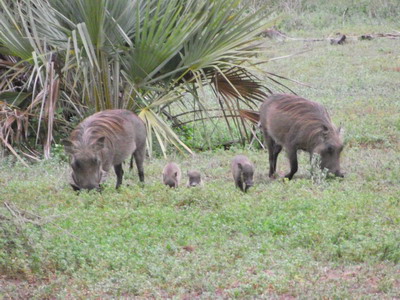
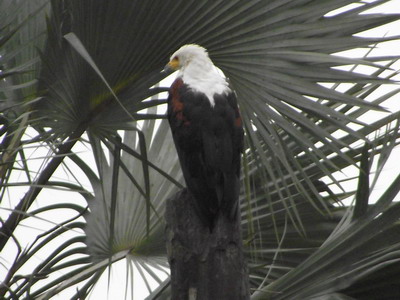
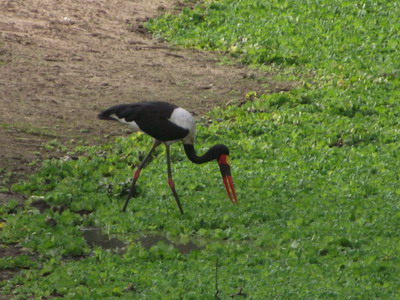
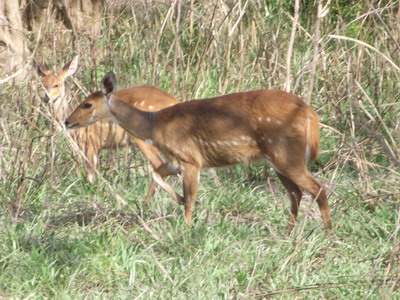
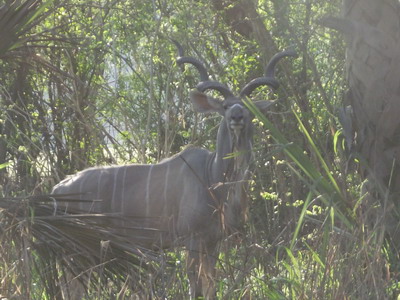
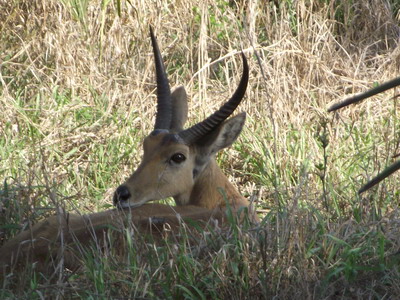
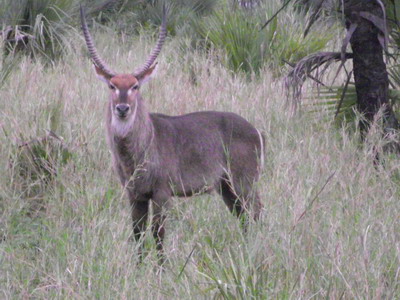
We
even saw 1
elephant; the only sighting that week by visitors. There are many
elephants in
a certain area of the Park. Two weeks ago when a rogue elephant
attacked a private
car the area was closed off. The scientists Peter ranli and Joyce
Poole are studying the elephants in an
attempt to
discover whether this behavior will be repeated because the elephants
remember
the poaching and the killings of their tribe by the rebels in the civil
war or
whether this is just display behavior and the elephants will calm down.
In the
meantime you can go to their
website to learn about their Gorongosa project.
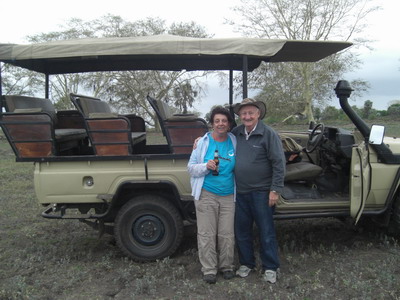
When we stopped on a huge flood plain for
drinks to sip beer, Simba suddenly rushed for his
binoculars
and told us to get back quickly into the jeep. We drove 250 meters and
managed
to see a lioness chasing a waterbuck while the lion gave up and stood
in the
grass. Later on the same flood plain we
saw a magnificent lion lying in the grass with two lionesses a few
meters
behind him. Simba said that was most probably Chinga, the lion that
took over
the pride the night before. It was quite
thrilling. At dinner we learnt from the researchers and the National
Geographic photographers that a while ago it was decided
to collar MO2 (see This Week's
Picture).
When the team drove up and fired a dart into MO2's side he
began to
wobble. To the amazementof the
researches, one lioness
actually
pulled out the dart from his side and chewed, then spat it out. When he began to topple the lionesses did not
leave him as was expected. The lionesses were a potential danger to the
lion and a definite danger to the researchers and photographers
and with some difficukty they chased the lionesses away. After placing
the collar with the GPS around his neck, they circled the lion with the
truck to protect him until he regained
consciousness.

Chinga,
the
lion we saw at a distance lying in the grass, attempted to displace MO2
this week.
The
photographic team for National Geographic were concerned when 2 of the
5 lion
cubs
disappeared and they were afraid that Chinga had killed them. But the
next day
when we saw MO2 they thought that MO2 had reinstated himself and
perhaps the
cubs had joined a different pride.
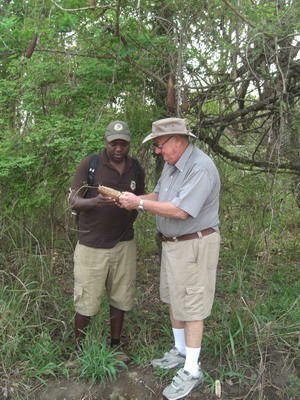
Our
second day
at the Park was very different. It was a
day spent at a different rhythm from our ' now' culture and internet
dependence. After
breakfast we met Simba and walked toward
Vinho region. As we walked along the path, men walking or on bicycles
passed
us in the opposite direction on their way to work in the Park. Over 400
people
from the surrounding villages are employed either in the hotel or in
the Park.
We
stopped to watch
an army of Matabele ants crossing the path on their way to raid a
termite mound. We peered into the
tiny volcano-like
depressions that the lion ant makes to catch its prey We examined the
fibrous inner body of the pod of the cucumber tree which is used like a
sponge. We
passed a sausage tree – never sleep under a sausage tree for if a
sausage falls
on you, you can get concussion!
We
eventually
reached the river and climbed into a metal boat with a flat bottom. The
boat uses
an engine in the rainy season but the river is so low now that the
boatman had
to pole the boat across the river. There is no charge as it is part of
the park
service for the workers.
After
about an
hour's walk we reached Vinho village It consists mainly of clusters of
mud huts
surrounded by mango and pawpaw trees and small plots of land, still
overrun by weeds. We passed the brick house of the
nurses'
quarters and the clinic. On the roof there were solar panels – not for
heating
water – but to give light and run a fridge for the medicines. At the
village
pump I tried my hand at pumping water. Not too difficult, but there was
no way
I could raise the 20kilo yellow jerrycan onto my head as all the women
do. In
fact I could hardly lift it.
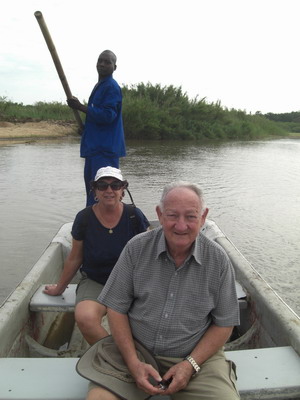
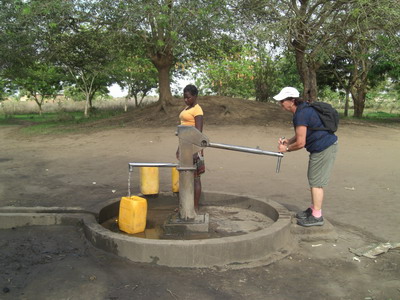
We
continued to
the primary school. The clinic and the school buildings are funded by
the Carr
Foundation. The teacher of class five and the headmaster came out to
speak to
us. The school has 600 students, 7 teachers and about 60 children to a
class in
two sessions a day. Schooling is free mainly because they don' have the
money
to pay. Children who go on to high school, after grade 7, must move to
Beira,
so few children do. When we entered the
class all the kids jumped to attention and greeted us in Portugese. We
were
surprised at the number of locals who speak Portugese in addition to
Tsonga, their
local tongue. In the teachers' study room Eitan noticed that they
study a single subject the whole day.
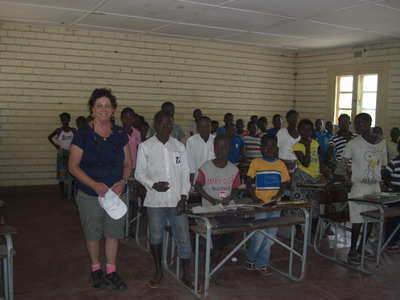
We
continued
along the dusty main street and saw the local cinema – wooden benches
in a hut
with the movie powered by a solar panel. The few shops were shut as
everyone
was at work. Two women were frying piles of dough and placing them in
plastic
bags to sell later. On a table selling
tomatoes, cabbage and some lettuce
leaves, we saw two dry little cobs of pale yellow corn, nothing like
the corn
we eat. In the fields it was mainly women, often with children on their
backs,
who were hoeing the patches, before planting maize
in preparation for the coming rainy
season. It is
back-breaking work
When
we crossed
the river there was a young boy wheeling his bicycle across the river.
Unfortunately our guide wouldn't let me cross by foot.
In
the
afternoon we did another drive and saw many birds and much the same
animals as
we saw yesterday, except we were meters away from MO2, the collared
lion. He
gave us a little show by getting up, scratching himself and then
ambling past
us, stopping to scent the air as the sun was shining through the hairs
around
his mouth and emphasizing his huge teeth. Afterward he plopped himself
in the
shade. Our lion experts assured us that at nightfall he would give a
huge roar
and his pride would gather around him for the night. Had he been
displaced?
One
day we
drove three hours to Mount
Gorongosa. The roadside was lined with logs
of charcoal for sale and when we got to the mountain it was
virtually
denuded of trees. The Mocambique
government agreed to add the mountain to the Park Reserve on condition
that the
Carr Foundation reforested the area. We met an
agriculture specialist from England who is helping plant coffee trees
in the shade of the other planted. trees. Native
to Africa coffee will also help supply the locals with a source of
income.
We
walked for 1 1/2 hour past scattered huts and stalls selling second
hand clothes
(to whom???), and banana and pineapple plantations and arrived at the
magnificent Murimbodzi waterfall.Unending plentiful water. What a
treat! When I dived into a pool of water
half way up
the
mountain I thought I would have a heart attack as the water was so
cold. On the way back by the river we saw women pounding maize which
they then washed in the water.
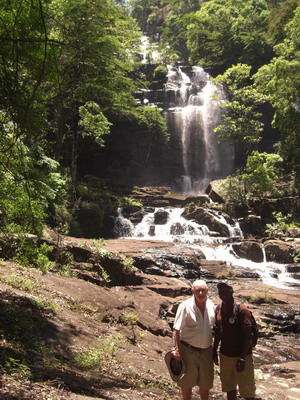
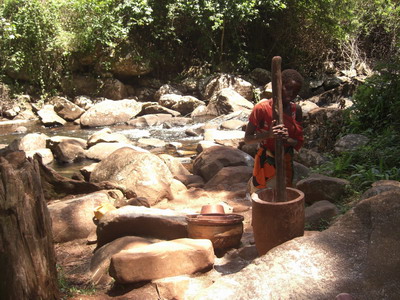
On our last drive we went to Bua Maria to see the sunset. As we stood
on the ridge we looked at the long Pungue River winding its way to the
Indian Ocean. "Afrika," in all its mystique and appeal was
displayed before us as as the red sun slowly slipped behind the
mountains,